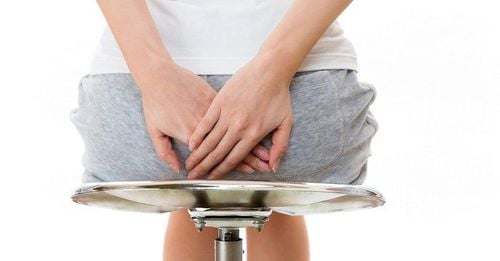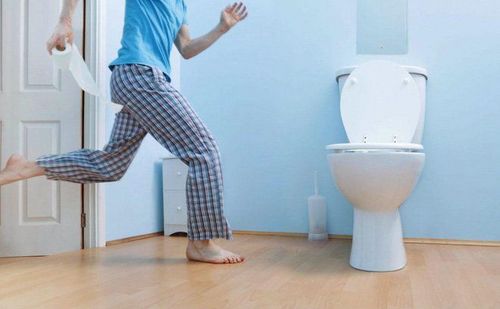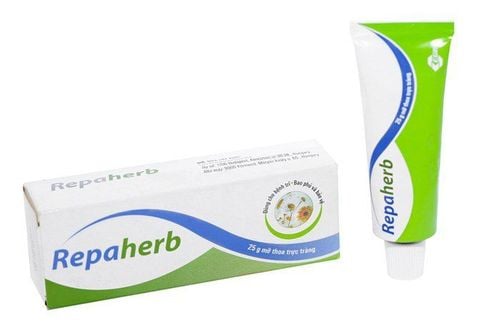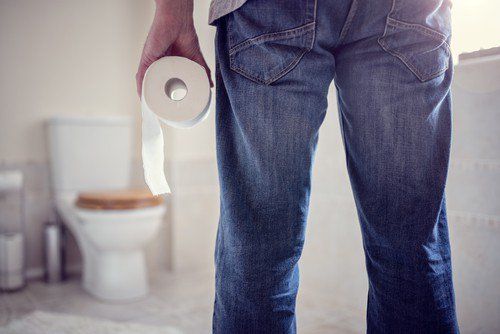This is an automatically translated article.
The article was professionally consulted by MSc Duong Xuan Loc - Gastroenterologist, Department of General Surgery, Vinmec Da Nang International General Hospital.The nature of hemorrhoids is the vascular plexus in the anal canal, when the blood is not circulated, the veins become stagnant and stretch and gradually dilate, depending on the level, causing more or less hemorrhoids. The swollen veins push the lining of the rectal canal to dilate, because the thin wall of the vessel is stretched, so the blood is easily penetrated out and the mucosa will be seen as congested and fragile. Over time, the degree of dilatation is more severe and prolapsed.
1. Risk factors and causes of hemorrhoids
Constipation, or diarrhea increases the frequency of hemorrhoids, straining increases pressure on the veins causing dilatation and blood stasis. Diets low in fiber, increase the frequency of hemorrhoids. Being overweight and obese increases the frequency of the disease. Increased intra-abdominal pressure is seen in people who often do heavy work such as porters, weightlifters, tennis players, ..., standing for a long time, sitting a lot such as clerks, tailors, sales staff working as housekeepers. Increased intra-abdominal pressure impedes the return of blood to the heart leading to anal varicose veins. Tumors in the pelvic region include colorectal tumors, uterine tumours, and many months of pregnancy, which impede blood return to the heart, causing varicose veins. See also: Hemorrhoids from A to Z: Causes, signs and effective treatment
2. Classification of hemorrhoids
Hemorrhoids are mainly of 2 types, including internal hemorrhoids (internal hemorrhoids) and external hemorrhoids (external hemorrhoids):
External hemorrhoids: When hemorrhoids originate below the dentate line (also known as the anorectal line), called external hemorrhoids. The hemorrhoid is now covered with squamous epithelium and lies beneath the skin surrounding the anus. Internal hemorrhoids: If the hemorrhoid originates above the dentate line, it is called an internal hemorrhoid, and the hemorrhoid is covered with mucosa and transitional epithelium. Hemorrhoid grading: based on the progression of hemorrhoids that are still inside or have prolapsed from the anus.
1st degree hemorrhoids: hemorrhoids are completely located in the anal canal. Grade 2 hemorrhoids: when normally hemorrhoids lie neatly in the anal canal, when pushing to defecate, hemorrhoids protrude or protrude a little. After going to the toilet, stand up and the hemorrhoid will retract inside. Grade 3 hemorrhoids: every time you go to the toilet or walk a lot, squat, do heavy work, the hemorrhoids prolapse. At this time, you have to lie down for a while before the hemorrhoids recede or gently push in with your hands. Grade 4 hemorrhoids: hemorrhoids are almost always located outside the anal canal.
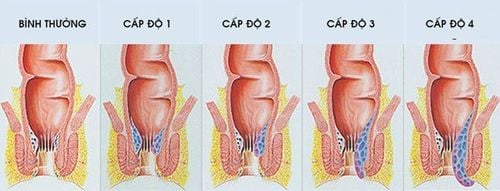
Các cấp độ trĩ
3. Clinical symptoms
3.1. Functional symptoms Blood in the stool is a common symptom and a reason for patients to visit the doctor. Blood is usually bright red, dripping or streaking at the end of the stool like "chicken discharge", sometimes bleeding on light impact, prolonged bleeding and often the cause of anemia in hemorrhoids. Prolapsed hemorrhoids out of the anal canal when defecating, walking or squatting for a long time, first retracts on its own, then pushes up and finally prolapses frequently. Itching or irritation in the anal area due to mucus secretion from the mucosa of the anal canal. Pain or discomfort, which ranges from painless, mild pain to very painful anal fissures, obstruction, or strangulation. Swelling around the anus. 3.2. Entity Rectal examination is mandatory when examining anorectal in general and examining hemorrhoids in particular. The purpose of rectal examination is not only to diagnose by palpation of the hemorrhoid (soft, pressurized) but also not to miss other pathologies where hemorrhoids are only a symptom (rectal cancer) and early symptoms. kit to assess anal sphincter tone. Have the patient squat to defecate to see the extent of prolapse and bleeding of the hemorrhoids. Proctoscopy : When you see purple hemorrhoids at the foot of the hemorrhoid located at any position compared to the dentate line, you can see a messy ring of many hemorrhoids, in addition to detecting other diseases. Physical examination to detect other diseases where hemorrhoids are just one manifestation.
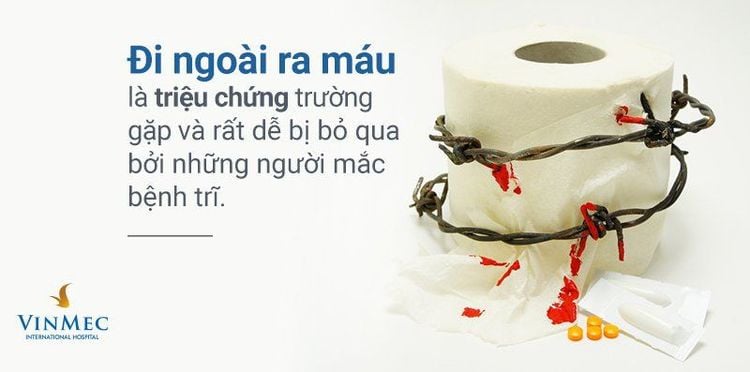
Đại tiện ra máu là triệu chứng thường gặp của bệnh trĩ
4. Treatments
4.1. Principles of Hemorrhoids Treatment Do not treat symptomatic hemorrhoids unless there are complications. Only treat hemorrhoids when there are disorders affecting life, work and health. Depending on the specific lesions of hemorrhoids, appropriate treatment methods are selected. 4.2 Medical treatments Medical treatment is applied to grade I hemorrhoids and mostly grade II hemorrhoids.
Diet high in fiber (vegetables, flour, cereals) and stool softeners, drink more water Avoid straining when passing stool to help limit the prolapse of hemorrhoids. Soak the anus in warm water 2-3 times a day, 10 minutes each time. Use rectal drugs, drugs that strengthen the vascular wall. Don't assume that anorectal bleeding is always caused by hemorrhoids. Cancer must be ruled out by colonoscopy and colonoscopy Hemorrhoids treatment: oral pills, ointments and suppositories marketed to prevent pain, prevent bleeding, treat hemorrhoids and other anorectal diseases, Currently, some drugs are still sold on the market such as Grinkor Fort, Proctolog, Daflon Traditional medicine currently has many valuable works, researching or re-studying some ancient remedies, applied to treat hemorrhoids. Oriental medicine has the advantage of using plants, easy to find, and cheap. 4.3. Surgical treatments Procedural interventions Elastic band ligation is the best method for grade I and II internal hemorrhoids (not for external hemorrhoids). Your doctor will warn you in advance that when hemorrhoids fall off, from day 6 to day 10 there may be light bleeding. If you have pain, urinary retention, and fever, a follow-up visit is needed to rule out an infectious syndrome of the perineum. Sclerotherapy is indicated for grade I and grade II hemorrhoids, especially in immunocompromised patients or with coagulopathy. Sclerotherapy is performed by injecting 1-2 ml of a sclerosing agent, which is 5% phenol, quinine, urea hydrochloride, polidocanol or sodium tetradecyl sulfate, injected with a needle under the lining of the hemorrhoid. Infrared photocoagulation is indicated for grade I, II hemorrhoids. Hemorrhoid laser ablation is indicated for grade II hemorrhoids. Note: These surgical interventions need to be performed by specialists and should be performed in hospitals.
Surgical interventions Classic surgery: Direct hemorrhoidectomy by Milligan - Morgan, Feguson or White heat methods for grade III and IV internal hemorrhoids, mixed hemorrhoids or complicated hemorrhoids. Directly cutting the hemorrhoids will lose the anal canal cushion, causing the patient to have fecal incontinence. In addition, direct intervention in the hemorrhoids will damage the nerve endings in the anal canal. causing prolonged pain to the patient.
Suture surgery to remove hemorrhoids by Longo method: Since 1993, author Antonio Longo, an Italian surgeon, has proposed cutting hemorrhoids by Longo method, using a cutting machine and sutures, this kit. by Johnson & Johnson; Manufacturer: PPH03. This is a disposable tool so the price is not cheap. Surgery is based on the principle of pulling the hemorrhoid back to its normal position, cutting and suturing the blood supply to make the hemorrhoid shrink. Cuts and sutures on the less sensitive area of the anal canal provide significant postoperative pain relief for the patient.
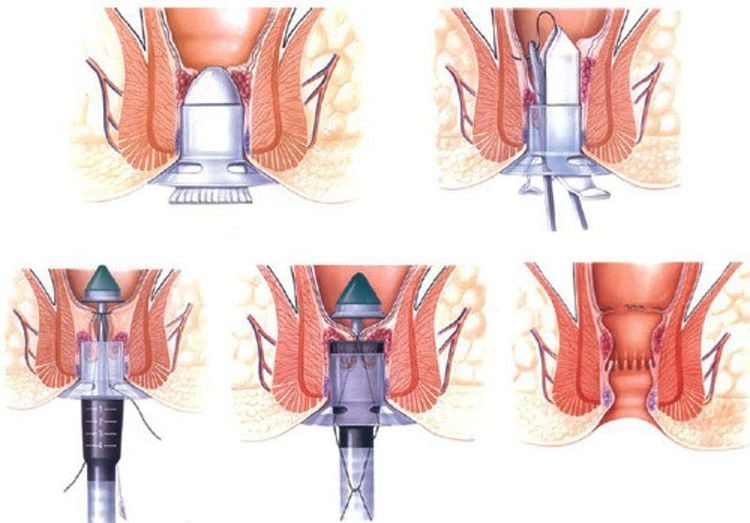
Cắt trĩ bằng phương pháp Longo
Advantages: After surgery, the patient can return to normal activities as soon as possible. The shortest hospital stay (3-4 days, special cases can be discharged in the same day). Postoperative pain and first defecation are significantly reduced compared to other surgical methods. With Longo hemorrhoidectomy, patients only need to use oral analgesics, feeling only mild discomfort in the area. anus.
Surgical suturing hemorrhoids under the guidance of Doppler ultrasound (THD): indicated for internal hemorrhoids from grade I to grade III. The goal is to cut off the source of the artery that runs under the mucosa to reach the hemorrhoid plexus to make the hemorrhoids shrink. Use Doppler to identify the hemorrhoidal arteries, then ligation these arteries with stitches 2 - 3 cm above the dentate line. The prolapsed hemorrhoids will then be fixed back into the anal canal by the longitudinal sutures of the anal canal. This technique is simple, safe, effective and less painful after surgery. However, there are cases where the hemorrhoidal vessels are missed
5. Note when treating hemorrhoids
Hemorrhoids should be examined early with an anorectal specialist. Depending on the extent of the hemorrhoid damage, there is an appropriate treatment.
Complications of acute hemorrhoids can be pain, infection, bleeding, and urinary retention. The longer hemorrhoids go untreated, the more difficult it is to control late complications. Should not because self-deprecating is a disease in the private area, so shy when going to the doctor
What should you eat when you have hemorrhoids? Hemorrhoids are very common, but each of us can prevent ourselves by having healthy eating and living habits: drink more water, defecate on time, avoid sitting for a long time, should not abuse alcohol and hot spicy foods. ... This also applies to reduce symptoms of hemorrhoids, support disease treatment.
Eat more foods containing fiber: Recommended foods include: Whole grains (barley, wheat, corn, brown rice, millet, rye, oats...), fruits, vegetables tubers... help increase stool volume, soften stools. Drink plenty of water: Drink 2 liters of water a day with other liquids, except alcohol, to aid digestion and soften stools. Hemorrhoids eat fruit, what fruit is suitable? Everyone should eat the recommended amount of fiber per day, 25 grams per day for women and 40 grams per day for men. Adding more fruits such as bananas, papaya, grapefruit ... will help improve symptoms, reduce bleeding hemorrhoids effectively.





